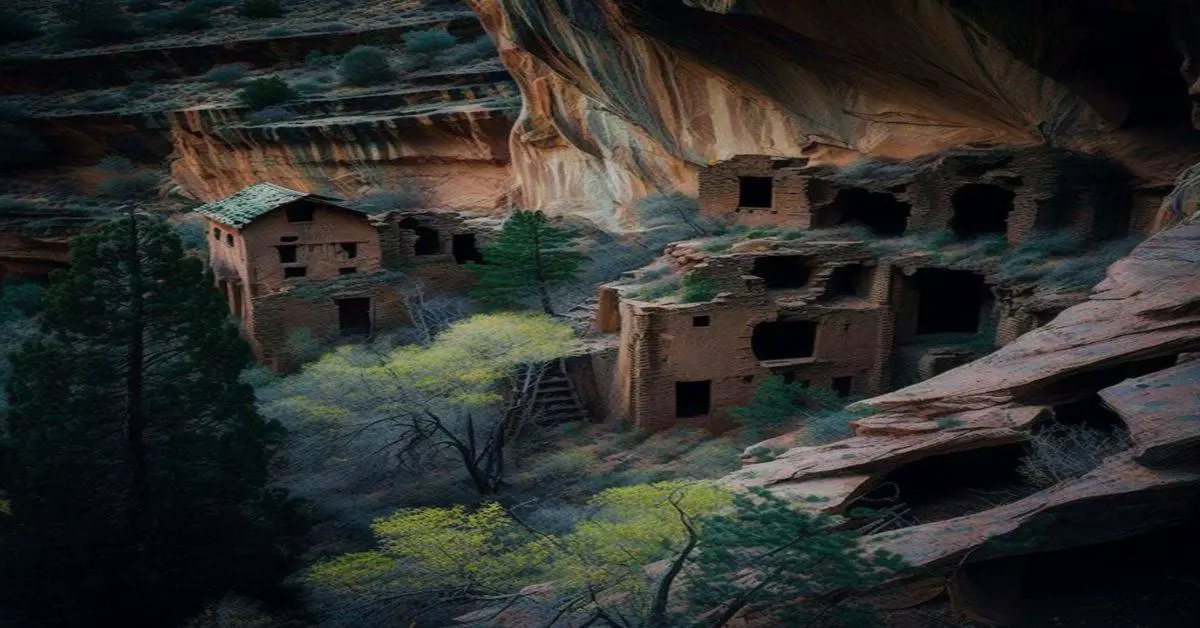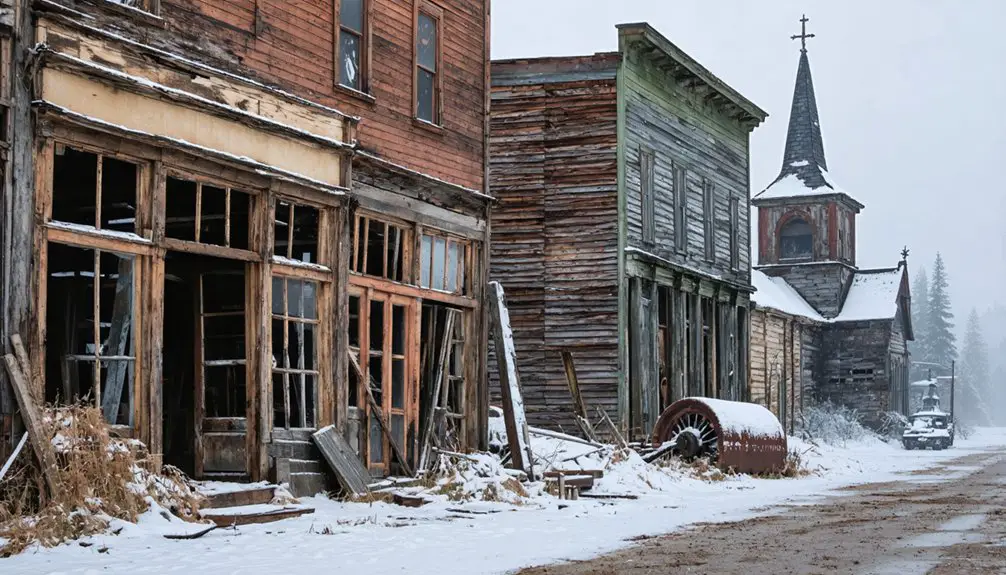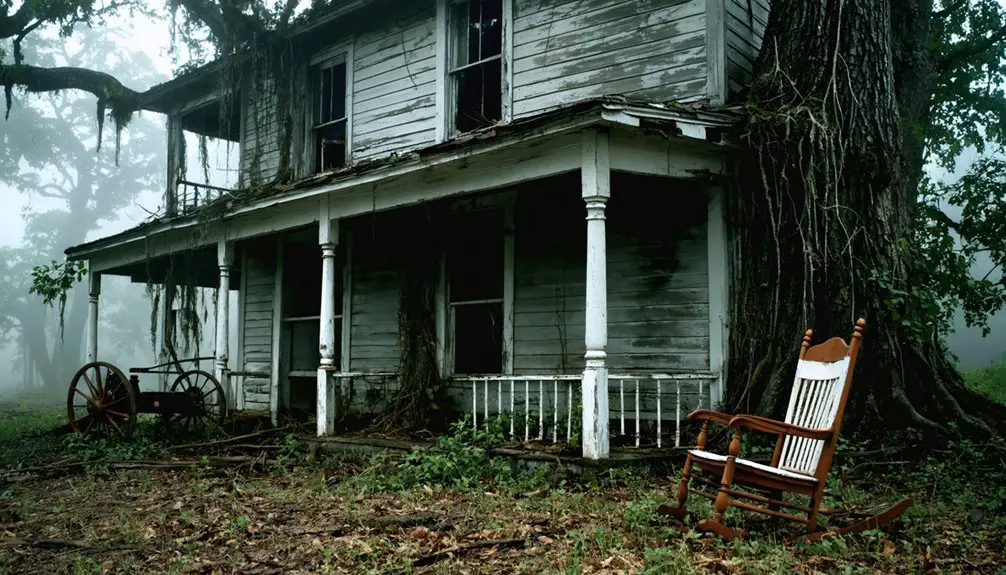You’ll discover Stotesbury nestled deep in Raleigh County’s forests, where nature’s reclaimed what was once West Virginia’s bustling coal town. After rich coal seams were found in 1889, the E.E. White Coal Company transformed this Winding Gulf Creek settlement into a thriving community of 20,000 residents. Today, you’ll find haunting remnants of company houses, churches, and industrial structures along overgrown paths, where local legends still echo through the abandoned mines.
Key Takeaways
- Stotesbury was a thriving coal mining town that peaked at 20,000 residents before becoming abandoned after mine closures in 1958.
- The E.E. White Coal Company provided housing and employment for thousands of families during the town’s prosperous mining era.
- St. John’s Baptist Church and Stotesbury Community Church were central to community life before the town’s decline.
- Modern visitors must navigate collapsed buildings and overgrown paths, as nature has reclaimed most of the abandoned structures.
- Historical preservation efforts continue through photographs and oral histories, while the remote location adds to its ghost town mystique.
The Birth of a Coal Mining Paradise
When exposed coal seams were discovered along Winding Gulf Creek in 1889, few could have predicted that this rugged terrain in southern West Virginia would give birth to one of the region’s most bustling coal towns.
You’ll find that Stotesbury’s story began with local families like the Phillips, who first tapped into the hillside coal using simple mining techniques. These early mines typically accessed 3 to 6 foot thick coal seams that were ideal for extraction.
But it wasn’t until the E.E. White Coal Company established operations that the town truly took shape. Named after Edward T. Stotesbury of the Beaver Coal Company, this settlement quickly transformed into a thriving mining camp. During its peak, the area supported a population of 20,000 people within a five-mile stretch.
Under E.E. White Coal Company’s leadership, Stotesbury emerged from wilderness to become a vital hub of Appalachian mining activity.
The precious Beckley seam drew companies like Koppers Coal, who launched formal operations in the late 1930s. The rich bituminous coal deposits you’d find here made Stotesbury a strategic gem in West Virginia’s industrial crown.
Life in Stotesbury’s Golden Era
You’d have found Stotesbury bustling with activity during its peak years, as miners and their families gathered at St. John’s Baptist Church and the Stotesbury Community Church for both worship and social events.
The E.E. White Coal Company established the original mining operations that brought the first families to the area. After long days in the Beckley seam, workers would strengthen their community bonds through church activities that served as the bedrock of local life. The final shift at the #8 mine marked a turning point for the close-knit mining community in 1981.
The coal camp’s tight-knit atmosphere extended beyond the mines, creating lasting connections that would define the town’s cultural legacy for generations to come.
Thriving Mining Community Life
During the peak years of the 1930s, Stotesbury bustled with life as nearly 20,000 residents packed into a five-mile stretch along Winding Gulf Creek.
You’d find a tight-knit community bound together by their shared mining heritage, where families lived in company-owned houses within walking distance of the mines. The E.E. White Coal Company, and later Koppers Coal, provided the backbone of employment that kept the town thriving.
Life revolved around the miners’ schedules, with workers descending into the Beckley seam daily via mine cars. On March 26, 1981, the last shift before midnight marked a significant moment as miners prepared for an impending contract strike.
Despite the demanding and dangerous conditions underground, the community’s resilience shone through in their organized labor actions and strong union presence.
The mining companies controlled most aspects of daily life, from housing to shopping at company stores.
Church and Theater Culture
Beyond the daily rhythms of mine work, Stotesbury’s cultural heart beat strongest in its churches and gathering spaces.
You’d find the wooden, clapboard St. John’s Baptist Church serving as the spiritual center for African-American families since 1918, while the Stotesbury Community Church welcomed other residents. The church remained active until early 1980s abandonment as the congregation gradually left the area. These weren’t just places of worship – they’re where you’d celebrate life’s milestones, share community news, and find solace from mining’s harsh realities.
While theatrical performances and entertainment venues weren’t extensively documented in Stotesbury, they played crucial roles in coal town life.
Like neighboring mining communities, you’d likely have encountered traveling shows and local productions that brought much-needed entertainment to hardworking families, though segregation often determined who could attend and where they could sit.
The Town’s Industrial Infrastructure
You’ll find Stotesbury’s industrial might centered around its extensive mining operations, which included the Helen Mine No. 11‘s equipment yards and processing facilities near the railroad junction.
The town’s lifeblood flowed through the Chesapeake & Ohio and Norfolk & Western rail lines, which transported coal and supplies while connecting miners to distant markets.
Today, visitors can explore the company houses and other remnants of this once-bustling mining community.
The complex network of water management systems, essential for mining operations, included drainage tunnels and treatment facilities that kept the mines operational through the peak production years. Senator Robert C. Byrd grew up in this industrial landscape before his rise to political prominence.
Mining Equipment and Facilities
The industrial backbone of Stotesbury centered on its sophisticated mining equipment and facilities, which evolved dramatically from basic hand tools to advanced mechanization throughout the 20th century.
You’ll find evidence of this mining machinery evolution in the shift from early undercutting machines to automated longwall systems that revolutionized coal extraction. The coal processing facilities expanded alongside technological advances, creating an intricate network of conveyors and processing plants that defined the town’s industrial landscape. Before unionization efforts and safety reforms, miners in Stotesbury endured harsh working conditions under the watchful eyes of company mine guards. Large mining equipment like the Tiger Shovel became iconic symbols of industrial progress, frequently showcased to visiting business groups.
- Mine shafts like Helen Plant No. 11 showcased the latest mechanical innovations
- Loading machines replaced manual labor, boosting efficiency from 2% to 99% between 1935-1955
- Conveyor systems connected mining operations directly to processing facilities
- Longwall and continuous mining machines transformed underground extraction methods
Railroad Transport Network
While mining equipment powered Stotesbury’s coal extraction, an extensive railroad network served as its lifeline to the outside world.
You’ll find this town was strategically positioned along the Virginian Railway’s main line, which revolutionized coal export capabilities with its efficient grade and electric-powered operations.
The railroad’s infrastructure included loading stations where you could watch massive coal trains, sometimes stretching over two miles long, transport the region’s black gold to Atlantic ports.
What made Stotesbury’s rail connection particularly valuable was its access to the Virginian’s innovative system, which employed the era’s heaviest locomotives and most advanced loading facilities.
This gave local mines a competitive edge in reaching coastal markets, as the Virginian Railway specialized in moving large coal volumes with remarkable efficiency.
Water Management Systems
Managing Stotesbury’s extensive water systems proved vital for both industrial operations and daily life in this coal town. The company constructed a complex network of gravity-fed pipelines and pump stations that distributed water from nearby streams and rivers throughout the settlement.
Water quality management became essential as mining operations expanded, requiring specialized drainage systems to prevent flooding and control contamination.
- Steel and cast iron pipes carried water through the rugged terrain, demanding constant maintenance to prevent costly breaks.
- Settling ponds trapped sediment from mine runoff before water discharge into local waterways.
- Separate drainage channels protected both mining operations and residential areas from flood risks.
- Storage reservoirs guaranteed steady water pressure for coal washing and dust suppression in the mines.
You’ll still find remnants of these engineering feats scattered across the mountainside, evidence of the town’s industrial legacy.
Social Fabric and Community Life

During its heyday, Stotesbury’s social fabric wove together around 20,000 inhabitants who shared their lives within the carefully planned confines of this model company town.
You’d find community interactions flourishing at every corner – from St. John’s Baptist Church’s towering steeple to the bustling theater and schools. Social rituals marked life’s milestones: weddings echoed through church halls, children played on sanctuary steps, and neighbors gathered to mourn their dead.
Yet beneath this unity lay stark divisions, evident in the segregated churchyard that separated residents even in death.
Even in death’s equalizing embrace, the town’s segregated cemetery spoke volumes about the divisions that persisted in life.
When the mines began closing in 1958, the tight-knit community unraveled. As jobs disappeared, so did the theaters, shops, and schools that had given Stotesbury its vibrant pulse, leaving only memories of a once-thriving coal town.
Notable Residents and Local Legends
The souls of Stotesbury’s past still echo through its abandoned streets, where the footsteps of notable residents once shaped the town’s character.
You’ll find the haunting legacy of coal miners who spent generations working the depths, their spirits now said to linger in abandoned homes and mine shafts. The ghostly presences are particularly strong near St. John’s Baptist Church, where locals claim to witness mysterious sightings.
- Church pastors and teachers formed the backbone of community leadership
- Company officials lived in prominent homes, directing miners’ daily lives
- Storekeepers controlled the economic pulse through company stores
- Miner spirits are said to walk the grounds of the segregated churchyard
These stories paint a vivid picture of life and death in this once-thriving coal town, where past and present blur in the mountain mist.
The Beginning of the End
As coal demand plummeted across America in the mid-twentieth century, Stotesbury’s once-prosperous mines began their fatal descent into obsolescence.
You’d have witnessed the economic impact ripple through every corner of this proud mining town, as dangerous roof conditions forced the final mine closures by 2002, ending nearly 90 years of coal production.
The heart-wrenching exodus that followed tested community resilience like never before.
You’d have seen your neighbors packing up their lives, leaving behind empty homes and shuttered businesses.
St. John’s Baptist Church, once the spiritual anchor of the community, fell silent.
Its deteriorating walls and collapsed roof became painful symbols of decline.
Remnants of a Forgotten Town
Walking through Stotesbury today, you’ll find haunting remnants of racial segregation etched into the town’s deteriorating landscape. The abandoned architecture tells a stark story of division, with separate churches for Black and white miners now standing in various states of decay.
Nature steadily reclaims these silent structures, as vines crawl up weathered walls and forest growth obscures segregated cemeteries.
- Collapsed roofs and broken steeples mark where communities once gathered to worship separately
- Mining equipment lies scattered among overgrown foundations, rusting tributes to industrial heritage
- Segregated cemeteries, their headstones barely visible through thick vegetation, preserve a divided past
- Company houses stand empty, their glassless windows staring like hollow eyes into a forgotten era
These physical remains serve as powerful reminders of America’s complex history of racial segregation and coal town life.
Exploring Stotesbury Today
Modern-day expeditions to Stotesbury demand careful planning and a rugged spirit, since reaching this remote ghost town requires traversing challenging terrain and unmaintained backroads.
You’ll need a 4×4 vehicle and local guidance to safely navigate the area, as conventional vehicles won’t cut it.
Once you arrive, you’ll discover a haunting tableau where nature’s reclaimed the remnants of coal camp life.
The collapsed St. John’s Baptist Church stands as a silent sentinel, while ghost stories whisper through deteriorating foundations and overgrown paths.
Natural decay has transformed most structures into crumbling ruins, creating an eerily peaceful atmosphere.
Unlike busier ghost towns in the New River Gorge, you’ll likely have Stotesbury’s sacred solitude all to yourself – perfect for photography and quiet contemplation of West Virginia’s industrial past.
Preserving the Legacy
Preserving Stotesbury’s legacy poses unique challenges in an era where time and nature wage constant battle against the town’s remaining structures.
You’ll find historical restoration efforts hampered by the town’s remote location and lack of economic resources, yet community engagement persists through dedicated locals who keep memories alive.
- St. John’s Baptist Church stands as a stark reminder of what’s at stake, with its collapsed roof and missing steeple bell serving as silent witnesses to decades of decay.
- The overgrown cemetery, where segregation-era headstones slowly fade into obscurity, desperately needs attention to preserve essential historical records.
- Paul Schutzer’s Life Magazine photographs provide significant documentation of the town’s decline after the 1958 mine closure.
- Local ghost stories and oral histories, including the famous Zona Shue tale, keep the cultural fabric intact despite physical deterioration.
Frequently Asked Questions
Are There Any Paranormal Investigations or Ghost Hunting Activities in Stotesbury?
You won’t find organized paranormal tours or documented ghost sightings here, though urban explorers visit informally. Local folklore suggests supernatural presence, but there’s no formal ghost hunting activity or investigations happening.
What Happened to the Mining Equipment After the Mines Closed?
Like steel giants falling into slumber, mining equipment was either salvaged for scrap metal, sold to recycling centers, or left to rust. You’ll find some pieces preserved as historical artifacts.
Can Visitors Legally Access and Photograph the Abandoned Buildings?
You’ll find no clear ghost town regulations, so access is legally ambiguous. It’s best to get local permission for photography, respect private property boundaries, and stay outside unstable buildings.
Were Any Major Accidents or Disasters Recorded in Stotesbury’s Mining History?
You won’t find major disaster reports or mining fatalities specifically documented for this location in official records, though the mines likely experienced the typical hazards common throughout West Virginia’s coal industry.
Do Any Former Residents Organize Reunions or Maintain Connections Today?
Like scattered leaves from an old family tree, you won’t find organized reunions today. Former residents maintain loose community connections through personal visits and online memory-sharing, but no formal gatherings exist.
References
- https://westvirginiamedialab.com/lost-towns-of-west-virginia-forgotten-places-and-their-stories/
- https://victoryrollsandv8s.wordpress.com/2013/08/02/ravaged-st-johns-baptist-of-stotesbury-west-virginia/
- https://rsftripreporter.net/deepest-west-virginia-bmw-tour-southern-coal-country/
- https://burningrockwv.com/burning-rock-history/
- https://www.coalcampusa.com/sowv/gulf/stotesbury/stotesbury.htm
- https://kids.kiddle.co/Stotesbury
- https://www.onlyinyourstate.com/trip-ideas/west-virginia/wv-mining-towns
- https://onview.lib.wvu.edu/catalog/004229
- https://newrivergorgecvb.com/abandoned-wv-coal-towns/
- https://onview.lib.wvu.edu/catalog/004171



